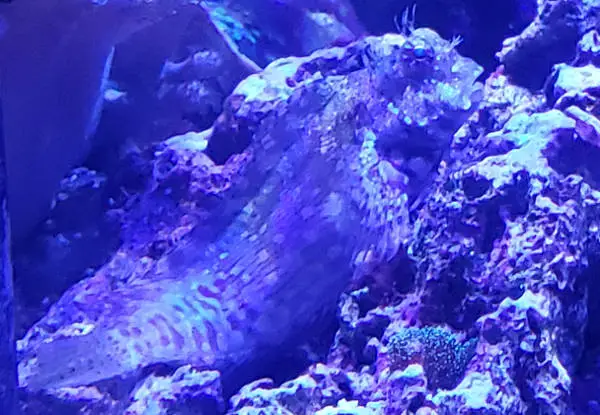
Salarias fasciatus
.
| Difficulty | Low |
| Minimum Tank Size | 30 Gallons |
| Diet | Herbivore |
| Water Parameters | 72-78 F, pH 8-8.4, Salinity 1.020-1.025 |
| Aggression | Peaceful |
| Size | 5" |
Lawnmower Blennies (Salaria fasciatus) , also known as Sailfin Blennies, are excellent algae eaters who loves to hop about on live rocks and substrate. They have a long, spiky dorsal and eye brows. They will often be seen perched upon a rock, observing the rest of the tank.
If you are looking to add the Lawnmower Blennies to a reef aquarium, do so with caution. These fish can nip at polyps and clams. Be ready to remove them if they harass your corals too much.
Lifetime
The Lawnmower Blenny is typically a long lived fish. When well cared for the fish can be expected to last anywhere from 2-6 years. The main offset to this is how the fish was obtained. Wild caught Lawnmower Blennies are often caught using poisons, which severely reduces their survival rate. If at all possible buy bred blennies rather than wild caught.

Diet & Feeding
Lawnmower blennies will graze on rocks, substrate and glass, keeping the tank algae free, with the exception of hair algae, and can eat prepared foods with ease.
It should be noted that lawnmower blennies should not be fed prepared foods unless they have no alternative. When Lawnmower Blennies are fed prepared foods they will often reduce or completely stop eating algae. Additionally many prepared foods are not made to support herbivores and will dramatically shorten their lifespan. Algae strips on the other hand make excellent food for lawnmower blennies who do not have enough natural algae to eat. These can be placed between rocks or even held in place by rubber bands. A special note is that blennies can be caught using cyanide, which causes them permanent damage. Try to get bred blennies whenever possible. If you suspect your lawnmower blenny has cyanide poisoning look for odd feeding habits. Most blennies caught in this method will only eat randomly, which typically shortens their lifetime dramatically. For this reason it is always best to ask the seller to feed the Lawnmower Blenny before purchasing them. If the blenny does not eat you may want to wait on the purchase and try again later.
Aggression
The Lawnmower Blenny is generally a peaceful fish that gets along with most tank mates. As with most other species they will be more hostile towards other fish that look similar to them. This includes most blennies and can be quite a big issue for some owners. Do not try to keep multiple Lawnmower Blennies unless you have a large take or are trying to pair them.
Remember: Lawnmower Blennies are fairly big compared to most blennies and can easily bully them. Likewise having the lawnmower blenny in the tank before any of the other fish can make them territorial. If you plan on keeping multiple blennies it is highly advised that you add the lawnmower blenny second.
If you are seeing more serious aggression, such as bullying of non-related fish or excessive clam nipping, try this process.
- Remove and quarantine the blenny
- Rearrange the tank
- Allow some time for the other fish to establish territories. 2-3 days worked for my sailfin
- Return the lawnmower blenny at night
This will work for almost any fish who is overly aggressive, however I have had great success using this method to defend my scooter blennies.
A final note here is about clams and urchins. Lawnmower blennies have frequently been spotted nipping at clams and urchins, causing them great stress. This is often caused by a lack of food or competition for food. If you have multiple algae eating fish the Lawnmower Blenny may feel the need to go for these unusual meals. Try to limit the number of algae eaters in smaller tanks.
Breeding & Sexing
Unfortunately this fish is just too difficult to tell the gender of. They have a massive number of characteristics, varying from one Lawnmower Blenny to another. The main quality that can be used to sex the fish are its rear fins. The females two spines on these fins are often smaller or even embedded where are the males are larger. The males will be bigger than the females, however this is difficult to notice without having a mated pair.
The female will then rest against the glass and begin laying a large number of eggs. These eggs will stick to the glass and substrate, making them difficult to remove and incubate.
When not kept in their own tank these eggs have a fairly low survival rate, as most fish will quickly eat a few of these eggs when passing by.
The tank does not need to meet any certain parameters for the fish to breed. The Lawnmower Blenny is even capable of laying eggs without a male in the tank. These of course will not hatch without a male present.